Caryodendron is a plant genus of the family Euphorbiaceae first described as a genus in 1860. The genus includes C. orinocense, known as the Inchi tree or Tacay nut. It is native to Central America and South America. They are dioecious trees.
- Caryodendron amazonicumDucke - Amazonas in Brazil
- Caryodendron angustifoliumStandl. - Costa Rica, Panama, Colombia
- Caryodendron janeirenseMüll.Arg. - Rio de Janeiro
- Caryodendron orinocenseH.Karst - Colombia, Venezuela, Ecuador
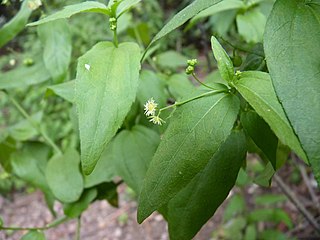
Chiropetalum is a plant genus of the family Euphorbiaceae first described as a genus in 1832. It is widespread across relatively dry regions of North and South America from Texas to Uruguay.
Angostylis is a genus of flowering plants in the family Euphorbiaceae, first described in 1854. The genus is native to northern South America.
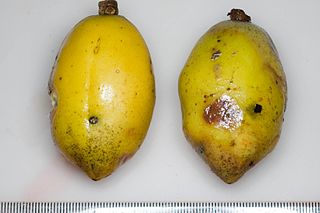
Glycydendron is a genus of plants, under the family Euphorbiaceae first described as a genus in 1922. It is native to South America.
- Glycydendron amazonicumDucke - French Guinea, Suriname, Guyana, Ecuador, Peru, Bolivia, northwestern Brazil, possibly Colombia
- Glycydendron espiritosantenseKuhlm, - State of Espirito Santo in Brazil
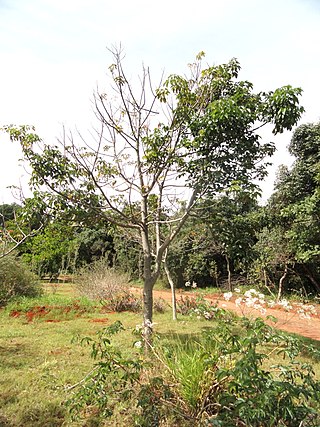
Joannesia is a genus of plants in the family Euphorbiaceae, first described as a genus in 1798. The entire genus is endemic to Brazil.
Micrandropsis is a plant genus of the family Euphorbiaceae first described as a genus in 1973. It contains only one known species, Micrandropsis scleroxylon, endemic to the State of Amazonas in northwestern Brazil.
Actinostemon is a plant genus of the family Euphorbiaceae first described as a genus in 1841. It is native to South America, Central America, and the West Indies.
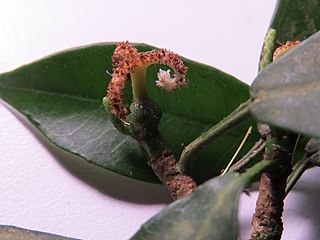
Algernonia is a plant genus of the family Euphorbiaceae first described as a genus in 1858. It is native to Peru and Brazil.
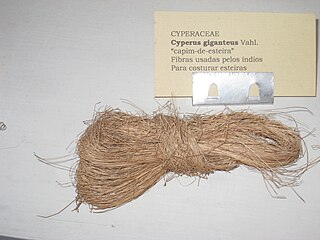
Cyperus giganteus is a perennial herbaceous plant. It belongs to the genus Cyperus. Its native range extends from Jalisco in west-central Mexico as far south as Uruguay, and also grows on some islands in the Caribbean. The species is sparingly naturalized in eastern Texas and southern Louisiana.

Campomanesia is a genus in the family Myrtaceae described as a genus in 1794. It is native to South America and Trinidad.
Mangonia is a genus of flowering plants in the family Araceae. The genus contains only two known species native to southern Brazil and Uruguay.
- Mangonia tweedieanaSchott. - Rio Grande do Sul, Uruguay
- Mangonia uruguaya(Hicken) Bogner - Cerro Largo in Uruguay
Alomiella is a genus of flowering plants in the family Asteraceae, described as a genus in 1972.

Albertinia is a genus of flowering plants in the daisy family described as a genus in 1820.

Bixa is a genus of plants in the family Bixaceae. It is native to Mexico, Central America, Caribbean, and South America, and naturalized in other places.

Centroglossa is a genus of flowering plants from the orchid family, Orchidaceae. It contains 5 accepted species, all endemic to Brazil:
- Centroglossa castellensisBrade - Espírito Santo
- Centroglossa greeniana(Rchb.f.) Cogn. in C.F.P.von Martius - Rio de Janeiro, São Paulo
- Centroglossa macrocerasBarb.Rodr.
- Centroglossa nunes-limaePorto & Brade - Minas Gerais, Espírito Santo
- Centroglossa tripollinica(Barb.Rodr.) Barb.Rodr.

Constantia is a genus of flowering plants from the orchid family, Orchidaceae. It contains 6 known species, all endemic to Brazil:
- Constantia australis(Cogn.) Porto & Brade - Santa Catarina
- Constantia cipoensisPorto & Brade - Minas Gerais
- Constantia cristinaeF.E.L.Miranda - Minas Gerais
- Constantia gutfreundianaChiron & V.P.Castro - Minas Gerais
- Constantia microscopicaF.E.L.Miranda - Minas Gerais
- Constantia rupestrisBarb.Rodr. - Rio de Janeiro

Herreria is a genus of flowering plants native to South America. In the APG III classification system, the genus is placed in the family Asparagaceae, subfamily Agavoideae.
- Herreria bonplandiiLecomte - Argentina, Paraguay, Uruguay
- Herreria cipoanaRavenna - Minas Gerais
- Herreria glazioviiLecomte - Bolivia, Brazil
- Herreria grandifloraGriseb. - Rio de Janeiro
- Herreria latifoliaWoodson - Minas Gerais, Bolivia
- Herreria montevidensisKlotzsch ex Griseb. in C.F.P.von Martius - Argentina, Paraguay, Uruguay, Bolivia
- Herreria salsaparilhaMart. - Brazil
- Herreria stellataRuiz & Pav. - Chile
Bradea is a genus of flowering plants in the family Rubiaceae. It was first described by Paul Carpenter Standley in 1932 and is named after the German botanist Alexander Curt Brade. All 6 species are endemic to Brazil, hence the name of the type species.
Eriothymus is a genus of flowering plant in the family Lamiaceae, first described as a genus in 1835. It contains only one known species, Eriothymus rubiaceus. It is endemic to the State of Minas Gerais in Brazil.
Bahiella is a genus of plants in the family Apocynaceae first described as a genus in 2006. The entire group is endemic to the State of Bahia in northeastern Brazil, the state after which the genus is named.










